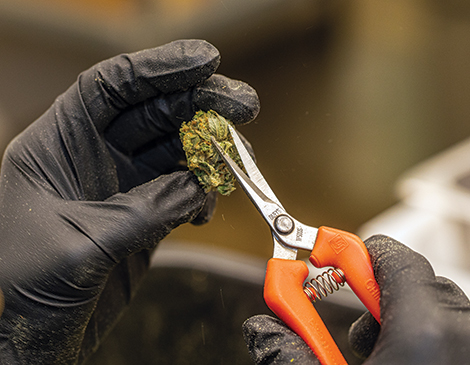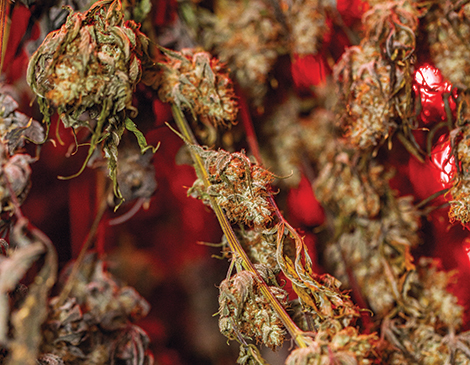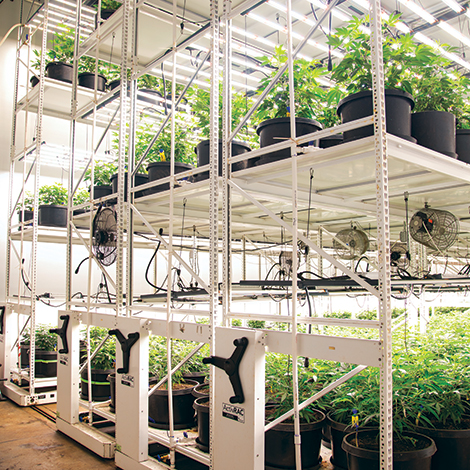How Ohio Growers Are Combating Marijuana Cultivation's Huge Carbon Footprint
by Patrick Williams | Feb. 28, 2024 | 12:00 PM

Heather Linn Young
Editor's Note: This article originally published in the March 2024 issue of Cleveland Magazine.
Galenas’ vertically tiered, LED-lit, indoor cannabis plants sprout from soil locally produced from compost. After harvest, the Akron business ships the used soil to Michigan, where it recycles it multiple times in outdoor and greenhouse grow cycles.
Galenas’ grow rooms encompass about 3,000 square feet of its roughly 11,000-square-foot facility. The cultivator cools rooms and dims and turns off lights as needed to keep plant flowers, or buds, compact to meet patient preferences — and it saves energy in the process. The team does not use pesticides on plants but feeds them with organic nutrients and amendments.
“We really intentionally went into what we are doing here in the state trying to be as thoughtful about what, not just our energy demand was going to be but, what our waste footprint was going to look like,” says Geoff Korff, Galenas founder and CEO.
Ohio’s marijuana industry is primed to expand beyond strictly medical operations to serve a ballooning consumer base, following voters’ decision to legalize weed in November 2023.
However, the industry — legalizing state by state and country by country — has riled some, including the climate-
conscious.
Estimates vary, but the industry likely produces somewhere between 0.07% and 0.1% of the nation’s total carbon footprint — the higher end being comparable to three million average cars, with CO2 emissions of 15 million tons. A 2021 study from Colorado State University found that Colorado’s cannabis industry contributes emissions comparable to trash collection and coal mining. The CO2 production of Oregon and Colorado’s cannabis industries have been estimated at 6% and 3%, respectively, of the state’s total emissions.
With four new states ready to launch recreational programs and at least 11 states considering it on the 2024 ballot, the industry is expected to grow from about $57 billion in 2023 to $444 billion in 2030. One can only assume that emissions will grow from here.
The biggest issue is indoor cultivation, which requires lighting, HVAC, dehumidification and other energy-
sucking tools that run 24 hours a day. Under Ohio’s medical marijuana program, all cultivation must take place in enclosed areas, like greenhouses. The same plan currently stands for the state’s to-come recreational industry, as outlined in Issue 2, the marijuana legalization initiated statute passed by Ohio voters on Nov. 7.
More than just crime prevention, there is a history with these protected grows, says Ari Seaman, managing partner of Off-Grid Agricultural Technologies and chief operating officer of C4 Holdings, a cannabis greenhouse in California City, California.

“Cannabis was illegal for so long that it was founded indoors,” he says. “It was founded in an attic, in a garage, in a closet.”
C4 Holdings’ operable, prototype greenhouse in California City separates itself from the energy grid by utilizing renewable energy sources — solar, wind, batteries and generators. Seaman rattles off several energy-saving processes at C4: induction lights that he invented, nutrient injection systems that measure soil humidity and a patent-
pending system called Programmable Load Management Logic that uses artificial intelligence to read weather patterns and adjust which power sources are used for various equipment.
That amounts to less energy and labor, Seaman says. C4 has reduced the carbon footprint of its 30,000-square-foot facility by about 90%.
Through OG AGtech, Seaman also works with a 300-acre Ohio field and greenhouse vegetable producer, The Chef’s Garden in Huron. Farmer Lee Jones, of The Chef’s Garden and Food Network fame, has chosen to use OG AG Tech’s AI weather-based system in his quest to increase efficiency.

Jeff McCourt, founder and CEO of Ohio medical marijuana company Firelands Scientific, says being located in Huron on the Lake Erie shore has proven to be ideal. About two-thirds of the light energy that the business’s plants use comes from the sun beaming through its greenhouse near the water.
“Weather patterns that create the lake effect snow in the eastern part of Lake Erie really clear up a lot of the cloud cover that exists otherwise in Ohio and Canada,” McCourt says.
Firelands Scientific’s 25,000 square feet of cultivation also uses a closed-loop hydroponic irrigation system.
The business employs sustainable packaging, such as glass and paper. It also obtains labels from Label Aid in Huron, and works with Huron’s Barnes Nursery to use plant material and growing media for compost.
McCourt plans to achieve a net-zero footprint for energy, waste and water by 2030, and with customers’ support of sustainability.

Government regulations can also influence operations’ energy use, with subsidies for using LED light bulbs.
In the meantime, Galenas will continue to follow sustainable approaches, such as partnering with local businesses like Tilth Soil in Cleveland and Ohio Earth Food in Hartville, which keeps distribution carbon emissions in check.
As for its used soil in Akron, Galenas aims to find a way to keep it in Ohio in the future. “It has to be sterilized to a certain extent in order to reuse it, and then reamended so that the fertility level is where it needs to be,” he says. “That’s all a bit beyond what our current building allows us to do. But eventually, I think we’ll get there.”
Nov. 7, 2023: Ohio’s Issue 2 passes with 57.19% of the vote, allowing adults ages 21 and older to possess and consume marijuana upon the law taking effect and subsequently permitting its eventual sale by and purchase from licensed businesses.
Dec. 6, 2023: Ohio’s Senate passes Senate Bill 86, which would raise the state’s point-of-sale tax from 10% to 15%, allow additional local taxes, change distribution of tax revenue and permit medical marijuana dispensaries to immediately begin selling weed. Gov. Mike DeWine urges the House to pass the bill to protect consumers from the illicit market.
Dec. 7, 2023: Issue 2 takes effect in the form by which it was passed by voters, making adult possession and use of marijuana legal.
Jan. 17, 2024: Gov. Mike DeWine calls on Ohio lawmakers to ban or regulate hemp-sourced, psychoactive delta-8 THC products.
Sept. 7, 2024: The Division of Cannabis Control is required to issue recreational marijuana cultivation, processing, testing and dispensary licenses to existing medical marijuana operators.
For more updates about Cleveland, sign up for our Cleveland Magazine Daily newsletter, delivered to your inbox six times a week.
Cleveland Magazine is also available in print, publishing 12 times a year with immersive features, helpful guides and beautiful photography and design.
Trending
-
1
-
2
-
3
-
4
-
5










